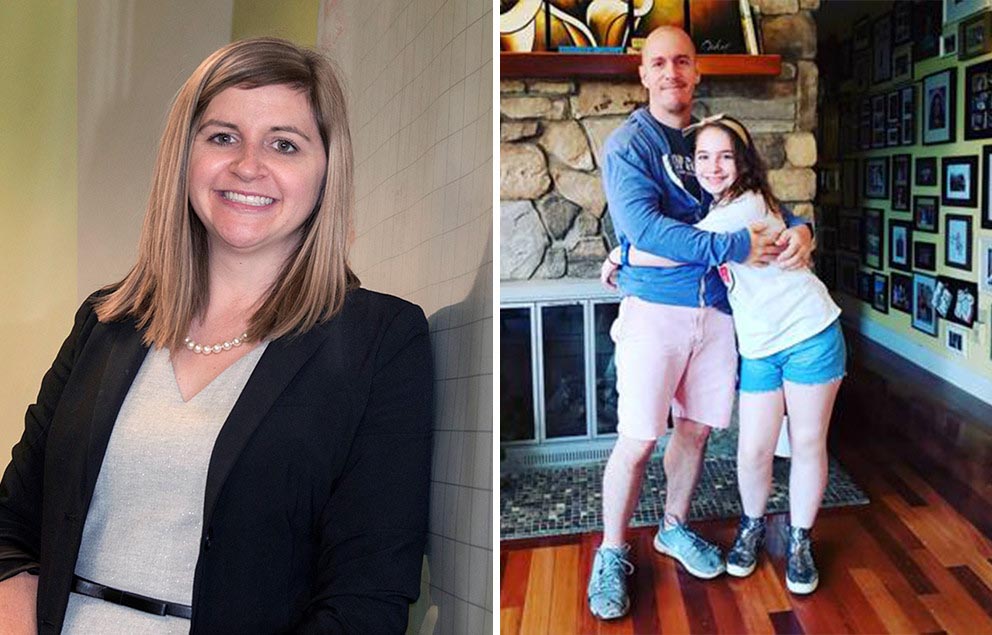
Scarlett Miller, associate professor of engineering design and industrial engineering, will focus on design fixation and the design process, and Sam Hunter, professor of psychology, will focus on the social science and psychological constructs as they work together to disrupt the creative process of people who seek to do harm. Hunter said he wants to contribute to creating a safer world for his daughter, Celia. IMAGE: PATRICK MANSELL/MELISSA HUNTER
Penn State professors study ways to 'disrupt malevolent creativity'
1/8/2021
By Susan Burlingame
UNIVERSITY PARK, Pa. — “Creativity is typically thought of as a positive, wonderful, benevolent thing,” said Sam Hunter, professor of psychology and director of Penn State’s industrial/organizational (I/O) psychology doctoral program. “The nice things we enjoy in our lives have an element of creativity to them, from medical advances to our favorite devices — but the truth is the bad guys are creative too.”
Hunter, along with co-principal investigator Scarlett Miller, associate professor of engineering design and industrial engineering and director of the engineering design program, are hoping to find ways to disrupt the “bad guys” with the help of a grant through the National Counterterrorism Innovation, Technology, and Education Center (NCITE), a U.S. Department of Homeland Security (DHS) center of excellence based at the University of Nebraska Omaha.
“A lot of the most harmful and destructive acts of terrorism have an element of creativity to them, which is often a painful thing to acknowledge,” explained Hunter, citing events such as the attacks of Sept. 11, 2001. “Destructiveness often comes from an element of novelty — which means we are often less prepared for it.”
Titled “Understanding Malevolent Creativity in Terrorist Attacks,” the project is part of a $35 million DHS funding stream that includes grants to some 15 different universities. Through their research, Hunter and Miller, along with Penn State I/O psychology doctoral student Kayla Walters, are seeking to better understand malevolent creativity and to determine if there are active interventions to prevent it.
“My role is to provide insight from the engineering side,” explained Miller. “I will look at our research on design fixation and its role in the design process and how that can relate over to counterterrorism. Sam will provide the social science lens to study in rigorous detail the psychological constructs of the mind that impact fixation, while I provide the technological lens to view it with how those types of factors apply to engineering creations.”
The research team will examine historical acts of violence and terror to analyze and better understand terrorists’ approaches, personality traits, tactics and more. The project also includes a human component, during which some 300 diverse subjects are given a creative problem to solve.
“We get back a range of different solutions to creative problems. Some are benevolent, some are completely innocuous, and some are a little bit darker,” said Hunter. “No one is asked to do anything nefarious, but in our research, the ‘darker’ responses are a good thing because they allow us to identify the sort of traits and qualities that might be associated with those kinds of creations. It also allows us to see whether the conditions we set up ultimately have an impact on things like malevolence and novelty.”
Industrial/organizational psychologists typically focus on increasing workplace productivity and solving employee issues in organizations, explained Hunter. For this particular project, however, he said the “o” in industrial/organizational psychology can be applied to organizations that mean to do harm.
“Terror organizations do many of the same things the IBMs and Microsofts of the world do,” he explained. “They select people. They train and develop them. They have leadership. They value creativity. If we can understand the kinds of people who work for these organizations and what set of personality traits drew them to that kind of malevolent creativity, we might be able to develop active interventions to interrupt it.
“It’s taking what we know about what good organizations do to get better — understanding the challenges they face and what do they do to improve creativity — and then flipping that to find ways to steer the bad guys to ultimately break up the process.”
“Penn State is the right place for this research because we have the cross-disciplinary expertise in the area that is really necessary to solve this complex problem,” said Miller. “One of the cool things about this project is that all of the work that we’ve done and most of the literature has really looked at how we can overcome design fixation — how we can keep people from getting fixated to inspire innovation. This project really takes that and turns it on its head and looks at how can we fixate people to try to keep them from coming up with really creative and innovative designs for terrorism.”
“The project is satisfying for a number of reasons, but in particular you can ultimately you feel like have an impact on helping people and keeping people safe,” said Hunter. “I have a nine-year-old daughter, and I am always thinking about how to keep this world safer for her. If things go the way we hope they do, the impact will be immeasurable in a lot of ways.”
“I think this has the potential to have a large impact on the defense industry and the world because of the role of terrorism in this process,” concluded Miller. “That’s what’s exciting to me about this project — the potential impact it can have.”



